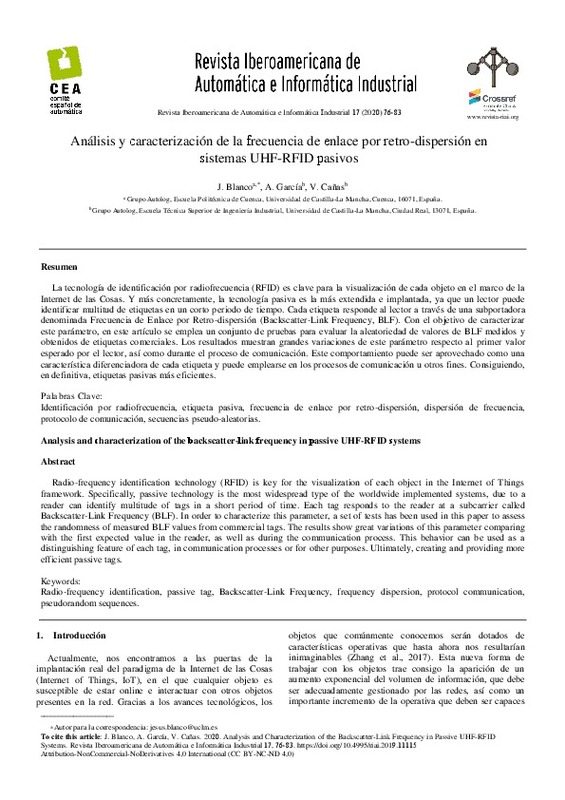Arjona, L., Simon, H., & Ruiz, A. 2018. Energy-Aware RFID Anti-Collision Protocol. Sensors, 18(6), 1904. https://doi.org/10.3390/s18061904
Badru, A., & Ajayi, N. 2017. Adoption of RFID in large-scale organisation - A review of challenges and solutions. In 2017 IST-Africa Week Conference (IST-Africa) (pp. 1-10). IEEE. https://doi.org/10.23919/ISTAFRICA.2017.8102394
Bagheri, N., Alenaby, P., & Safkhani, M. 2017. A new anti-collision protocol based on information of collided tags in RFID systems. International Journal of Communication Systems, 30(3), e2975. https://doi.org/10.1002/dac.2975
[+]
Arjona, L., Simon, H., & Ruiz, A. 2018. Energy-Aware RFID Anti-Collision Protocol. Sensors, 18(6), 1904. https://doi.org/10.3390/s18061904
Badru, A., & Ajayi, N. 2017. Adoption of RFID in large-scale organisation - A review of challenges and solutions. In 2017 IST-Africa Week Conference (IST-Africa) (pp. 1-10). IEEE. https://doi.org/10.23919/ISTAFRICA.2017.8102394
Bagheri, N., Alenaby, P., & Safkhani, M. 2017. A new anti-collision protocol based on information of collided tags in RFID systems. International Journal of Communication Systems, 30(3), e2975. https://doi.org/10.1002/dac.2975
Bratuz, I., Vodopivec, A., & Trost, A. 2014. Resolving Collision in EPCglobal Class-1 Gen-2 System by Utilizing the Preamble. IEEE Transactions on Wireless Communications, 13(10), 5330-5339. https://doi.org/10.1109/TWC.2014.2350975
Chen, Y., Su, J., & Yi, W. 2017. An Efficient and Easy-to-Implement Tag Identification Algorithm for UHF RFID Systems. IEEE Communications Letters, 21(7), 1509-1512. https://doi.org/10.1109/LCOMM.2017.2649490
Choi, H., Kim, H., & Choi, S. 2017. Capture-Aware Couple-Resolution Blocking Protocol in RFID Systems. Wireless Personal Communications, 93(4), 969-986. https://doi.org/10.1007/s11277-016-3940-2
Dawei Shen, Woo, G., Reed, D. P., Lippman, A. B., & Junyu Wang. 2009. Separation of multiple passive RFID signals using Software Defined Radio. In 2009 IEEE International Conference on RFID (pp. 139-146). IEEE. https://doi.org/10.1109/RFID.2009.4911203
Duan, L., Zhang, X., Wang, Z. J., & Duan, F. 2017. A Feasible Segment-by-Segment ALOHA Algorithm for RFID Systems. Wireless Personal Communications, 96(2), 2633-2649. https://doi.org/10.1007/s11277-017-4316-y
GS1. (2016). EPC Information Services ( EPCIS ) Standard.
GS1. (2018). EPC TM Radio-Frequency Identity Protocols Generation-2 UHF RFID Specification for RFID Air Interface. Version 2.1.
Huang, K.-S., Hwang, C.-K., Lee, B.-K., & Chung, I.-H. 2017. An exact closed-form formula of collision probability in diverse multiple access communication systems with frame slotted aloha protocol. Journal of the Franklin Institute, 354(13), 5739-5752. https://doi.org/10.1016/j.jfranklin.2017.05.028
Salah, H., Ahmed, H. A., Robert, J., & Heuberger, A. 2015. FFT Based Rate Estimation for UHF RFID Systems. In Smart SysTech 2015 : European Conference on Smart Objects, Systems, and Technologies (pp. 1-5). Aachen, Germany.
Shoufeng, W., Dongchen, Z., Xiaoyan, X., Shumeng, S., & Tinglan, W. 2014. A novel anti-collision scheme for RFID systems. In 2014 IEEE World Forum on Internet of Things (WF-IoT) (pp. 458-461). IEEE. https://doi.org/10.1109/WF-IoT.2014.6803210
Solic, P., Maras, J., Radic, J., & Blazevic, Z. 2017. Comparing theoretical and experimental results in Gen2 RFID throughput. IEEE Transactions on Automation Science and Engineering, 14(1), 349-357. https://doi.org/10.1109/TASE.2016.2532959
Su, J., Sheng, Z., Hong, D., & Wen, G. 2016. An Effective Frame Breaking Policy for Dynamic Framed Slotted Aloha in RFID. IEEE Communications Letters, 20(4), 692-695. https://doi.org/10.1109/LCOMM.2016.2521839
White, G., Nallur, V., & Clarke, S. 2017. Quality of service approaches in IoT: A systematic mapping. Journal of Systems and Software, 132, 186-203. https://doi.org/10.1016/j.jss.2017.05.125
Wijayasekara, S. K., Robithoh, A., Sasithong, P., Vanichchanunt, P., Nakpeerayuth, S., & Wuttisittikulkij, L. 2017. A Reduced Complexity of Vahedi's Tag Estimation Method for DFSA. Engineering Journal, 21(6), 111-125. https://doi.org/10.4186/ej.2017.21.6.111
Wu, H., Wang, Y., & Zeng, Y. 2018. Capture-aware Bayesian RFID tag estimate for large-scale identification. IEEE/CAA Journal of Automatica Sinica, 5(1), 119-127. https://doi.org/10.1109/JAS.2017.7510757
Yong, W., Qing, L., Lei, W., & Hao, S. 2017. Research on Anti-Collision Algorithm in Radio Frequency Identification Technology. In 2017 9th International Conference on Intelligent Human-Machine Systems and Cybernetics (IHMSC) (pp. 239-244). IEEE. https://doi.org/10.1109/IHMSC.2017.167
Zhang, T., Li, Q., Zhang, C.-S., Liang, H.-W., Li, P., Wang, T.-M., … Wu, C. 2017. Current trends in the development of intelligent unmanned autonomous systems. Frontiers of Information Technology & Electronic Engineering, 18(1), 68-85. https://doi.org/10.1631/FITEE.1601650
[-]









